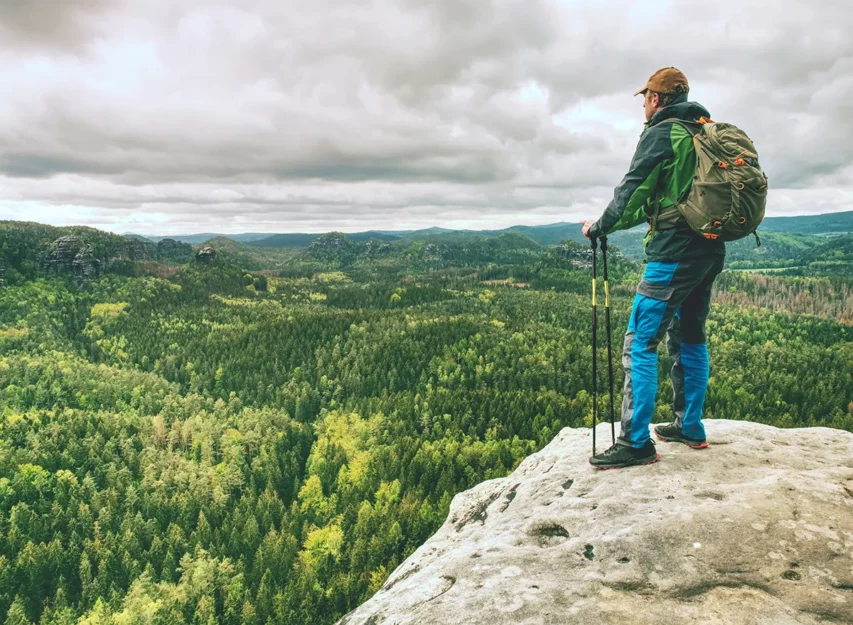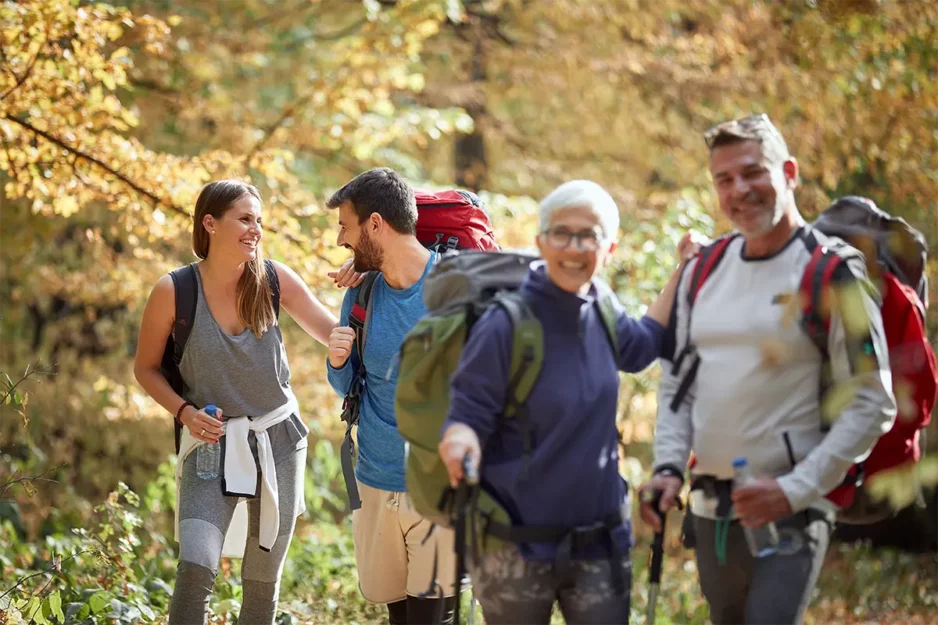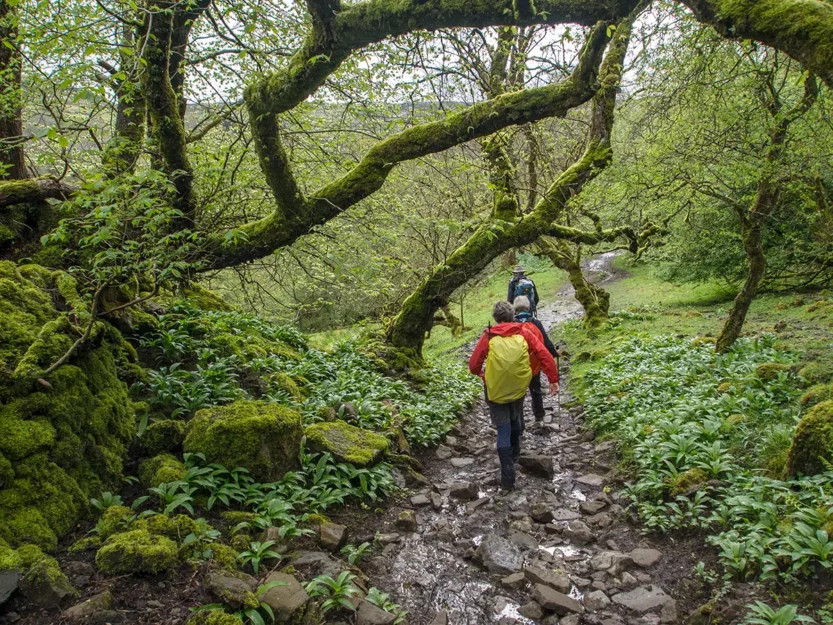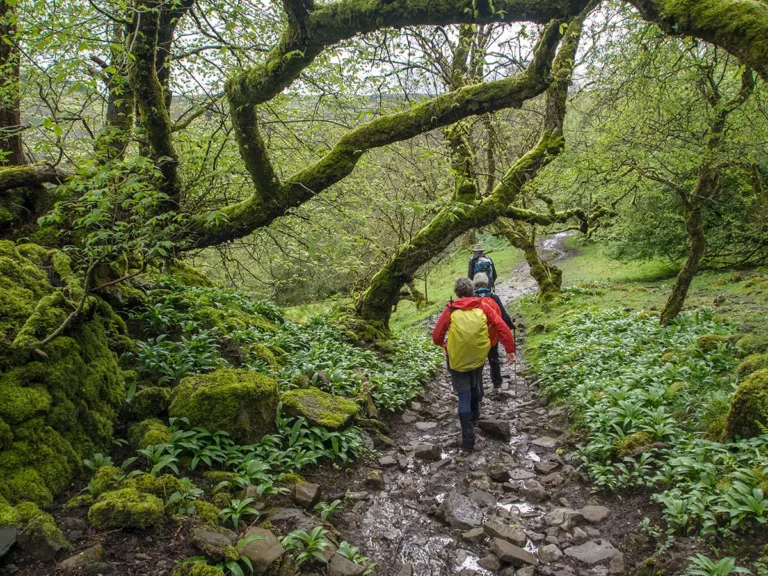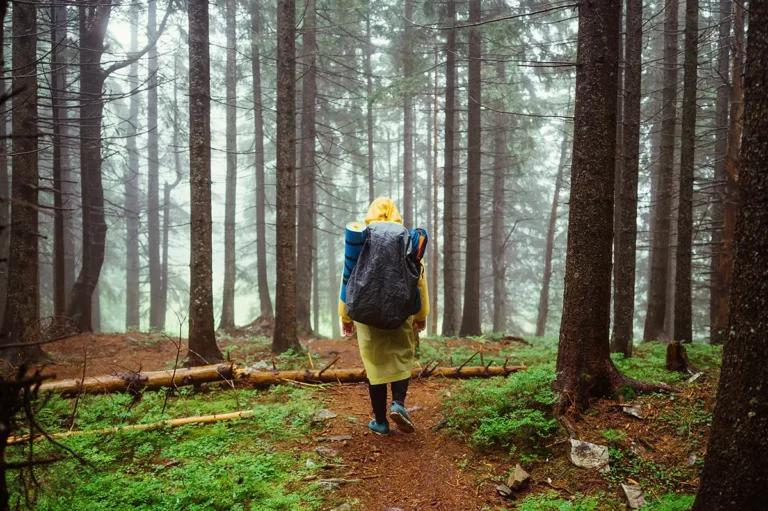Good news! You don’t need the latest full-grain leather hiking boots, ten-pocket zip-off hiking pants, and a $200 REI windbreaker to go on a hike. And you don’t need to dress like you’re going on a safari.
On most trails, you can get by wearing what’s in your closet, then adding essential pieces as you hike more regularly. A perfectly fine hiking outfit in nice weather can be:
- Cross-trainer shoes
- Synthetic gym shorts or joggers
- Moisture-wicking synthetic shirt
In fact, If I were to recommend one single purchase, it would probably be hiking socks.
This article breaks down the dos and don’ts of trail attire so you know what to wear hiking and what to avoid.
What to wear hiking: A guide for new hikers
The excitement of being invited on a hike can abruptly end when you realize you don’t know what to wear for hiking.
Although the essential hiking gear will be necessary as you progress to more challenging hikes, an easy trail is typically well-maintained and manageable to navigate with workout clothes.
This raises the most crucial question, did you research your trail?
Without the proper hiking attire, stick to hikes of 3 miles or less with elevation gains of fewer than 300 feet. Out-and-back trails are best for new hikers since you’re never surprised by the difficulty of the return hike.

What NOT to wear hiking
Cotton kills is a popular mantra amongst hikers, Scouts, and Park Rangers. Referring to the absorbent properties inducing hypothermia when hiking in cold weather, the same principle applies even in perfect weather.
The comfort and cooling properties of cotton are unbeatable for everyday wear, but cotton makes an awful material for physical activity.
When you sweat, the body relies on a process of evaporative cooling — moving moisture away from the skin — to physically cool the body.
Since cotton absorbs, the damp, slow-drying material prevents the sweat from evaporating and cooling, risking heat-related illness.
And cotton shirts aren’t the only material to avoid. Denim cotton is equally as bad, making hiking in jeans a big no-no.
What shoes to wear hiking
Protecting your feet on hikes is paramount, making shoes the most essential item. Shoes are your connection to the loose, dangerous ground, and accidents account for 62% of trail deaths, led by traumatic brain injury.
Meanwhile, fifty percent of injuries are sprains and strains of knees, ankles, and back due to slips, falls, and overuse.
Many new hikers think a boot of any kind is the next best alternative, opting for black leather combat-style boots or even cowboy boots. Many easy hiking trails are well maintained, not requiring a traditional, high-ankle boot. Hiking shoes are even gaining in popularity over boots.
Not many people own trail running shoes, but if you do, it’s your best option. I frequently wear my trail runners hiking.
Cross-trainers are one shoe most have in their closet. Since they offer some grip, plus the stability needed for training and exercise, hiking in cross trainers can get you comfortably across an easy trail.
Regardless of your choice, play it safe, and don’t push the limits. Irritations you don’t feel running errands all weekend will show up after several hiking miles. Hiking demands a high level of comfort and stability for the feet.
Aside from slips and falls, wearing the wrong footwear risks toe numbness, joint pain, muscle cramps, or even lead to hip and back strains.

What clothes to wear hiking
The climate, weather, and hike itself affect what to wear hiking. Will you be crossing creeks or starting early in the cold morning? You might need quick-drying or waterproof shorts and a light jacket or flannel you can easily pack away.
Under normal conditions, If your clothes can stand up to a strenuous gym workout or run, they can probably handle the trail. But hikes typically last longer than runs, which demands clothing that better protects you from harmful UV rays and keeps you dry in hot and cold climates.
Many features in clothes for hot weather hiking are the same for cold, just without the layers, such as:
Moisture-wicking synthetic materials
Moisture-wicking fabrics pull moisture from the skin to the exterior layer of the material. They also dry quickly.
Synthetic moisture-wicking materials are:
- Polyester
- Nylon
- Spandex
- Gore-Tex
- Polypropylene
Many activewear shirts are synthetic polyester and nylon blends, as are base layers for cold-weather hiking.
UPF rating
A white cotton T-shirt only has an ultraviolet protection factor (UPF) of about 5. UPF is similar to SPF, only for fabrics. A minimum UPF rating is 15, while an excellent rating is 50 or higher.
The synthetic blend’s tightly woven fabric block out more rays than loosely woven cotton.
Dark or bright materials
According to The Skin Cancer Foundation, dark or bright colors are the best skin protection against UV rays. The University of Utah Huntsman Cancer Institute recommends vivid, brightly colored shirts like yellow or orange.
Breathability
Many synthetic fabrics alone are excellent for moisture-wicking but terrible for breathability. For this reason, they blend with breathable fabrics or use a less tightly woven pattern to provide airflow.
The sweat needs to evaporate for your body to cool, and a non-breathable material will trap heat, even if it’s moisture-wicking.
Accessories to wear for hiking
Once you have your core hiking outfit figured out, consider accessories. Few hiking trails are shaded at all times, making you susceptible to sunburns and overheating.
To protect your head, wearing a wide-brimmed hat is best, with a neck gator and baseball hat combination a close second.
Cotton socks will leave your feet damp and uncomfortable. Instead, opt for Merino wool or a synthetic blend. Hiking socks are moisture-wicking and have padding in all the right places.
A small, lightweight backpack is ideal for storing water and snacks. You can ensure a cold drink hours later by freezing a couple of the bottles. It also helps to keep a sandwich cool for longer hikes or a scenic lunch.
Final thoughts
So long as you protect yourself from UV, heat, and cold while wearing comfortable shoes with enough grip to prevent a fall, you’ll be ok.
With clothing out of the way, it’s time to focus on bringing enough water and some snacks to replenish your electrolytes.
The University of Michigan Physical Activity Program recommends drinking 7 to 10 ounces of water for every 10 to 20 minutes of exercise, hydrating yourself before and after a hike is equally as crucial as on the trail.
Staying hydrated takes more than just water on long or hot hikes.
Electrolytes are essential minerals key to many of the body’s functions. When asked why electrolytes are important, Erika Der Sarkissian, a clinical dietician with Cedars Sinai, explains, “they regulate muscle contractions and keep you hydrated. Electrolytes also help balance your pH levels (the measure of acidity and alkalinity).”
Electrolyte replenishing snacks to bring with you on hikes are:
- Beef jerky & meat sticks
- Trail mix
- Dried fruits
- Banana
- Peanuts
- Granola bars
- Pretzels
Spending time in nature has incredible benefits for your mind and well-being. Put the phone away, take deep breaths of fresh air, and have a great, safe hike.
Do you know what to wear hiking now? Share this article on your socials to help and inspire others.


